Source Analysis and Contamination Assessment of Potentially Toxic Element in Soil of Small Watershed in Mountainous Area of Southern Henan, China
Abstract
:1. Introduction
2. Materials and Methods
2.1. General Situation of the Study Area
2.2. Sample Collection and Test
2.3. Matter Element Extension Analysis Method
- (1)
- Establish the matter-element matrix of the level of element contamination in soil
- (2)
- Determining the classical domain and node domain of the element to be judged
- (3)
- Determine the correlation degree function and calculate the correlation degree Tj(Ci)
- (4)
- Calculate the comprehensive correlation degree
- (5)
- Evaluation criteria
2.4. Pollution Index Method
2.4.1. Nemerow Comprehensive Pollution Index (PN)
2.4.2. Müller Index Method (Igeo)
2.5. PMF Method
2.6. Data Processing
3. Results and Discussions
3.1. Statistical Characteristics of Potentially Toxic Elements Content in Soil
3.2. Potentially Toxic Elements Contamination Assessment in Topsoil
3.2.1. Evaluation of Element Contamination by Matter-Element Extension Analysis
- (1)
- It is determined that the matrix of the matter element of E1 is:
- (2)
- According to Table 1, establishment of classical domain matrices E(1), E(2), E(3), E(4), E(5) and node field matrices E(p):
- (3)
- potentially toxic elements weight correction
- (4)
- Evaluation results
3.2.2. Evaluation Results of Nemerow Comprehensive pollution Index method
3.2.3. Evaluation Results of Müller Index Method
3.3. Correlation Analysis of Potential Toxic Elements in Soil
3.4. Analysis on the Source of Potential Toxic Elements in Soil
4. Conclusions
Author Contributions
Funding
Institutional Review Board Statement
Conflicts of Interest
References
- Ran, H.Z.; Guo, Z.H.; Yi, L.W.; Xiao, X.Y.; Zhang, L.; Hu, Z.H.; Li, C.; Zhang, Y. Pollution characteristics and source identification of soil metal (loid) s at an abandoned arsenic-containing mine, China. J. Hazard. Mater. 2021, 413, 125382. [Google Scholar] [CrossRef] [PubMed]
- Chaoua, S.; Boussaa, S.; El Gharmali, A.; Boumezzough, A. Impact of irrigation with wastewater on accumulation of heavy metals in soil and crops in the region of Marrakech in Morocco. J. Saudi Soc. Agric. Sci. 2019, 18, 429–436. [Google Scholar] [CrossRef]
- Ashraf, S.; Ali, Q.; Zahir, Z.A.; Ashraf, S.; Asghar, H.N. Phytoremediation: Environmentally sustainable way for reclamation of heavy metal polluted soils. Ecotoxicol. Environ. Saf. 2019, 174, 714–727. [Google Scholar] [CrossRef] [PubMed]
- Wei, L.L.; Wang, K.; Noguera, D.R.; Jiang, J.Q.; Oyserman, B.; Zhao, N.B.; Zhao, Q.; Cui, F. Transformation and speciation of typical heavy metals in soil aquifer treatment system during long time recharging with secondary effluent: Depth distribution and combination. Chemosphere 2016, 165, 100–109. [Google Scholar] [CrossRef] [PubMed]
- Li, C.F.; Cao, J.F.; Yao, L.; Wu, Q.Y.; Lv, J.S. Pollution status and ecological risk of heavy metals in the soils of five land-use types in a typical sewage irrigation area, eastern China. Environ. Monit. Assess. 2020, 192, 1–14. [Google Scholar] [CrossRef] [PubMed]
- Ciarkowska, K.; Gambus, F.; Antonkiewicz, J.; Koliopoulos, T. Polycyclic aromatic hydrocarbon and heavy metal contents in the urban soils in southern Poland. Chemosphere 2019, 229, 214–226. [Google Scholar] [CrossRef] [PubMed]
- Wu, D.; Yu, X.; Lai, M.; Feng, J.; Dong, X.; Peng, W.; Su, S.; Zhang, X.; Wan, L.; Jacobs, D.F.; et al. Diversified effects of co-planting landscape plants on heavy metals pollution remediation in urban soil amended with sewage sludge. J. Hazard. Mater 2021, 403, 123855. [Google Scholar] [CrossRef] [PubMed]
- Zhang, Y.; Wang, S.; Gao, Z.; Zhang, H.R.; Zhu, Z.H.; Jiang, B.; Liu, J.; Dong, H. Contamination characteristics, source analysis and health risk assessment of heavy metals in the soil in Shi River Basin in China based on high density sampling. Ecotoxicol. Environ. Saf. 2021, 227, 112926. [Google Scholar] [CrossRef]
- Gujre, N.; Mitra, S.; Soni, A.; Agnihotri, R.; Rangan, L.; Rene, E.R.; Sharma, M.P. Speciation, contamination, ecological and human health risks assessment of heavy metals in soils dumped with municipal solid wastes. Chemosphere 2021, 262, 128013. [Google Scholar] [CrossRef]
- United States Environmental Protection Agency (US EPA). Health Effects Assessment Summary Tables (HEAST), Annual Update; United States Environmental Protection Agency: Washington, DC, USA, 2016. [Google Scholar]
- Li, D.P.; Yu, R.D.; Chen, J.; Leng, X.; Zhao, D.H.; Jia, H.T.; An, S. Ecological risk of heavy metals in lake sediments of China: A national-scale integrated analysis. J. Clean. Prod. 2021, 334, 130206. [Google Scholar] [CrossRef]
- Huang, J.; Wu, Y.; Sun, J.; Li, X.; Fan, Z. Health risk assessment of heavy metal(loid)s in park soils of the largest megacity in China by using Monte Carlo simulation coupled with Positive matrix factorization model. J. Hazard. Mater. 2021, 415, 125629. [Google Scholar] [CrossRef] [PubMed]
- Wang, X.D.; Zhang, C.B.; Wang, C.; Zhu, Y.D.; Cui, Y.H. Probabilistic-fuzzy risk assessment and source analysis of heavy metals in soil considering uncertainty: A case study of Jinling Reservoir in China. Ecotoxicol. Environ. Saf. 2021, 222, 112537. [Google Scholar] [CrossRef] [PubMed]
- Tan, Z.F.; Ju, L.W.; Yu, X.B.; Zhang, H.J.; Yu, C. Selection ideal coal suppliers of thermal power plants using the matter-element extension model with integrated empowerment method for sustainability. Math. Probl. Eng. 2014, 2014, 11–22. [Google Scholar] [CrossRef] [Green Version]
- Wang, Y.L.; Li, F.; Yang, J.L.; Zhou, M.H.; Song, F.H.; Zhang, D.Y.; Xue, L.; Zhu, J. Demand response evaluation of RIES based on improved matter-element extension model. Energy 2020, 212, 118121. [Google Scholar] [CrossRef]
- Ren, S.Q.; Men, B.H.; Shen, Y.D. Water quality evaluation of Wenyu river in Beijing by matter element model. Nat. Environ. Pollut. Technol. 2021, 20, 1585–1591. [Google Scholar] [CrossRef]
- Li, P.Y.; He, S.; He, X.D.; Tian, R. Seasonal hydrochemical characterization and groundwater quality delineation based on matter element extension analysis in a paper wastewater irrigation area, northwest China. Expo. Health 2017, 10, 241–258. [Google Scholar] [CrossRef]
- Wang, X.L.; Wang, G.X.; Wu, Y.X.; Xu, Y.; Gao, H. Comprehensive assessment of regional water usage efficiency control based on game theory weight and a matter-element model. Water 2017, 9, 113. [Google Scholar] [CrossRef] [Green Version]
- Shan, C.J.; Dong, Z.C.; Lu, D.B.; Xu, C.D.; Wang, H.; Ling, Z.; Liu, Q. Study on river health assessment based on a fuzzy matter-element extension model. Ecol. Indic. 2021, 127, 107742. [Google Scholar] [CrossRef]
- Liu, S.L.; Li, W.P. Indicators sensitivity analysis for environmental engineering geological patterns caused by underground coal mining with integrating variable weight theory and improved matter-element extension model. Sci. Total Environ. 2019, 686, 606–618. [Google Scholar] [CrossRef]
- Wang, Y.L.; Yang, J.L.; Zhou, M.H.; Zhang, D.Y.; Song, F.H.; Dong, F.G.; Zhu, J.; Liu, L. Evaluating the sustainability of China’s power generation industry based on a matter-element extension model. Util. Policy 2021, 69, 101166. [Google Scholar] [CrossRef]
- Wang, X.D.; Zheng, W.D.; Tian, W.; Gao, Y.M.; Wang, X.Z.; Tian, Y.Q.; Li, J.; Zhang, X. Groundwater hydrogeochemical characterization and quality assessment based on integrated weight matter-element extension analysis in Ningxia, upper Yellow River, northwest China. Ecol. Indic. 2022, 135, 108525. [Google Scholar] [CrossRef]
- Li, X.X.; Liu, H.Y.; Meng, W.; Liu, N.T.; Wu, P. Accumulation and source apportionment of heavy metal (loid)s in agricultural soils based on GIS, SOM and PMF: A case study in superposition areas of geochemical anomalies and zinc smelting, Southwest China. Process Saf. Environ. Prot. 2022, 159, 964–977. [Google Scholar] [CrossRef]
- Ma, Y.K.; Mummullage, S.; Wijesiri, B.; Egodawatta, P.; McGree, J.; Ayoko, G.A.; Goonetilleke, A. Source quantification and risk assessment as a foundation for risk management of metals in urban road deposited solids. J. Hazard. Mater. 2020, 408, 124912. [Google Scholar] [CrossRef] [PubMed]
- Long, Z.J.; Zhu, H.; Bing, H.J.; Tian, X.; Wang, Z.G.; Wang, X.F.; Wu, Y. Contamination, sources and health risk of heavy metals in soil and dust from different functional areas in an industrial city of Panzhihua City, Southwest China. J. Hazard. Mater. 2021, 420, 126638. [Google Scholar] [CrossRef] [PubMed]
- Cheng, W.; Lei, S.G.; Bian, Z.F.; Zhao, Y.B.; Li, Y.C.; Gan, Y.D. Geographic distribution of heavy metals and identification of their sources in soils near large, open-pit coal mines using positive matrix factorization. J. Hazard. Mater. 2020, 387, 121666. [Google Scholar] [CrossRef]
- Fei, X.F.; Lou, Z.H.; Xiao, R.; Ren, Z.Q.; Lv, X.N. Contamination assessment and source apportionment of heavy metals in agricultural soil through the synthesis of PMF and GeogDetector models. Sci. Total Environ. 2020, 747, 141293. [Google Scholar] [CrossRef]
- Wang, J.H.; Wu, H.H.; Wei, W.X.; Xu, C.B.; Tan, X.; Wen, Y.; Lin, A. Health risk assessment of heavy metal(loid)s in the farmland of megalopolis in China by using APCS-MLR and PMF receptor models: Taking Huairou District of Beijing as an example. Sci. Total Environ. 2022, 835, 155313. [Google Scholar] [CrossRef]
- Fei, X.F.; Lou, Z.H.; Xiao, R.; Ren, Z.Q.; Lv, X.N. Source analysis and source-oriented risk assessment of heavy metal pollution in agricultural soils of different cultivated land qualities. J. Clean. Prod. 2022, 341, 130942. [Google Scholar] [CrossRef]
- Fang, H.X.; Gui, H.R.; Yu, H.; Li, J.; Wang, M.C.; Jiang, Y.Q.; Chen, C.; Wang, C. Characteristics and source identification of heavy metals in abandoned coal-mining soil: A case study of Zhuxianzhuang coal mine in Huaibei coalfield (Anhui, China). Hum. Ecol. Risk Assess. Int. J. 2021, 27, 708–723. [Google Scholar] [CrossRef]
- Wu, J.; Li, J.; Teng, Y.; Chen, H.Y.; Wang, Y.D. A partition computing-based positive matrix factorization (PC-PMF) approach for the source apportionment of agricultural soil heavy metal contents and associated health risks. J. Hazard. Mater. 2020, 388, 121766. [Google Scholar] [CrossRef]
- Chen, K.; Huang, L.; Yan, B.Z.; Li, H.B.; Sun, H.; Bi, J. Effect of lead pollution control on environmental and childhood blood lead level in Nantong, China: An interventional study. Environ. Sci. Technol. 2014, 48, 12930. [Google Scholar] [CrossRef] [PubMed]
- Zhu, X.; Yu, W.X.; Li, F.; Liu, C.Y.; Ma, J.L.; Yan, J.J.; Wang, Y.; Tian, R. Spatio-temporal distribution and source identification of heavy metals in particle size fractions of road dust from a typical industrial district. Sci. Total Environ. 2021, 780, 146357. [Google Scholar] [CrossRef] [PubMed]
- Qin, G.W.; Niu, Z.D.; Yu, J.D.; Li, Z.H.; Ma, J.Y.; Xiang, P. Soil heavy metal pollution and food safety in China: Effects sources and removing technology. Chemosphere 2021, 267, 129205. [Google Scholar] [CrossRef] [PubMed]
- Zhang, Z.Y.; Ying, L.J.; Mamat, Z.; Fu, Y.Q. Sources identification and pollution evaluation of heavy metals in the surface sediments of Bortala River, Northwest China. Ecotoxicol. Environ. Saf. 2016, 126, 94–101. [Google Scholar] [CrossRef]
- Yadav, I.C.; Devi, N.L.; Singh, V.K.; Li, J.; Zhang, G. Spatial distribution, source analysis, and health risk assessment of heavy metals contamination in house dust and surface soil from four major cities of Nepal. Chemosphere 2019, 218, 1100–1113. [Google Scholar] [CrossRef]
- Wang, S.; Cai, L.M.; Wen, H.H.; Luo, J.; Wang, Q.S.; Liu, X. Spatial distribution and source apportionment of heavy metals in soil from a typical county-level city of Guangdong Province, China. Sci. Total Environ. 2019, 655, 92–101. [Google Scholar] [CrossRef]
- Zhang, Y.X.; Wu, Y.; Song, B.; Zhou, L.; Wang, F.P.; Pang, R. Spatial distribution and main controlling factor of cadmium accumulation in agricultural soils in Guizhou, China. J. Hazard. Mater. 2022, 424, 127308. [Google Scholar] [CrossRef]
- Wang, Z.H.; Ma, B.S.; Ma, C.Q.; Zheng, C.Q.; Zhou, B.X.; Guo, G.Y.; Xia, T. Region identification of Xinyang Maojian tea using UHPLC-Q-TOF/MS-based metabolomics coupled with multivariate statistical analyses. J. Food Sci. 2021, 86, 1681–1691. [Google Scholar] [CrossRef]
- GB/T 22105.1-2008; AEPIMOA. Soil Quality—Determination of Total Mercury and Arsenic-Atomic Fluorescence Spectrometry—Part 2: Determination of Total Arsenic-Atomic in Soil. Standardization Administration of the People’s Republic of China: Beijing, China, 2008.
- DB41/T 811-2013; DEEHP. Determination of Antimony in Soil—Atomic Fluorescence. Administration for Market Regulation Henan Province: Zhengzhou, China, 2013. (In Chinese)
- GB/T 17138-1997; EMC. Soil quality—Determination of Antimony in Soil—Flame Absorption Spectrophotometric. Ministry of Ecology and Environment of the People’s Republic of China: Beijing, China, 1997.
- DZ/T 0295-2016; China University of Geosciences: Beijing; Hubei Geological Research Laboratory; Development and Research Center National Geological Archives of China. Specification of Land Quality Geochemical Assessment. Ministry of Land and Resources of the People’s Republic of China: Beijing, China, 2016.
- Lin, L.Q. Application of toxicological safety evaluation data to calculate the toxicity coefficient of heavy metals. In Proceedings of the 2009 Advanced Symposium on Heavy Metal Pollution Monitoring, Risk Assessment and Remediation Technology, Qingdao, China, 9 August 2009; pp. 60–63. (In Chinese). [Google Scholar]
- Håkanson, L. An ecological risk index for aquatic pollution control. A sedimentological approach. Water Res. 1980, 14, 975–1001. [Google Scholar] [CrossRef]
- GB 15618-2018; Nanjing Institute of Environmental Sciences, MEE. Soil Environmental Quality Standard for Controlling Soil Pollution Risk of Agricultural Land. Ministry of Ecology and Environment of the People’s Republic of China: Beijing, China, 2018.
- Yari, A.A.; Varvani, J.; Zare, R. Assessment and zoning of environmental hazard of heavy metals using the Nemerow integrated pollution index in the vineyards of Malayer city. Acta Geophys. 2021, 69, 149–159. [Google Scholar] [CrossRef]
- Müller, G. Index of Geoaccumulation in Sediments of the Rhine River. J. Geol. 1969, 8, 108–118. [Google Scholar]
- Cheng, H.X.; Li, K.; Li, M.; Yang, K.; Liu, F.; Cheng, X.M. Background and benchmark values of chemical elements in urban soils in China. Geosci. Front. 2014, 21, 265–306. (In Chinese) [Google Scholar] [CrossRef]
- Odewande, A.A.; Abimbola, A.F. Contamination indices and heavy metal concentrations in urban soil of Ibadan metropolis, southwestern Nigeria. Environ. Geochem. Health 2008, 30, 243–254. [Google Scholar] [CrossRef] [PubMed]
- Xia, F.; Zhang, C.; Qu, L.Y.; Song, Q.J.; Ji, X.L.; Mei, K.; Dahlgren, R.A.; Zhang, M. A comprehensive analysis and source apportionment of metals in riverine sediments of a rural-urban watershed. J. Hazard. Mater. 2020, 381, 121230. [Google Scholar] [CrossRef]
- Paatero, P.; Eberly, S.; Brown, S.G.; Norris, G.A. Methods for estimating uncertainty in factor analytic solutions. Atmos. Meas. Tech. Discuss. 2013, 7, 187–797. [Google Scholar] [CrossRef] [Green Version]
- Guo, G.H.; Wang, Y.T.; Zhang, D.G.; Li, M. Source-specific ecological and health risks of potentially toxic elements in agricultural soils in Southern Yunnan Province and associated uncertainty analysis. J. Hazard. Mater. 2021, 417, 126144. [Google Scholar] [CrossRef]
- Zhang, P.Y.; Qin, C.Z.; Hong, X.; Kang, G.H.; Qin, M.Z.; Yang, D.; Pang, B.; Li, Y.; He, J.; Dick, R.P. Risk assessment and source analysis of soil heavy metal pollution from lower reaches of Yellow River irrigation in China. Sci. Total Environ. 2018, 633, 1136–1147. [Google Scholar] [CrossRef]
- Tian, K.; Wu, Q.M.; Liu, P.; Hu, W.Y.; Huang, B.; Shi, B.; Zhou, Y.; Kwon, B.-O.; Choi, K.; Ryu, J.; et al. Ecological risk assessment of heavy metals in sediments and water from the coastal areas of the Bohai Sea and the Yellow Sea. Environ. Int. 2020, 136, 105512. [Google Scholar] [CrossRef]
- Sun, J.X.; Zhao, M.L.; Huang, J.L.; Liu, Y.F.; Wu, Y.Y.; Cai, B.Y.; Han, Z.; Huang, H.; Fan, Z. Determination of priority control factors for the management of soil trace metal (loid) s based on source-oriented health risk assessment. J. Hazard. Mater. 2022, 423, 127116. [Google Scholar] [CrossRef]
- Wang, Y.C.; Qiao, M.; Liu, Y.X.; Zhu, Y.G. Health risk assessment of heavy metals in soils and vegetables from wastewater irrigated area, Beijing-Tianjin city cluster, China. J. Environ. Sci. 2012, 24, 690–698. [Google Scholar] [CrossRef]
- Wang, Y.Z.; Duan, X.J.; Wang, L. Spatial distribution and source analysis of heavy metals in soils influenced by industrial enterprise distribution: Case study in Jiangsu Province. Sci. Total Environ. 2020, 710, 134953. [Google Scholar] [CrossRef] [PubMed]
- Zhuo, H.M.; Wang, X.; Liu, H.; Fu, S.Z.; Song, H.; Ren, L.J. Source analysis and risk assessment of heavy metals in development zones: A case study in Rizhao, China. Environ. Geochem. Health 2020, 42, 135–146. [Google Scholar] [CrossRef] [PubMed]
- Weissmannová, H.D.; Pavlovský, J. Indices of soil contamination by heavy metals—Methodology of calculation for pollution assessment (minireview). Environ. Monit. Assess 2017, 189, 616. [Google Scholar] [CrossRef] [PubMed]
- Alharbi, T.; El-Sorogy, A.S. Spatial distribution and risk assessment of heavy metals pollution in soils of marine origin in central Saudi Arabia. Mar. Pollut. Bull. 2021, 170, 112605. [Google Scholar] [CrossRef] [PubMed]
- Gupta, N.; Yadav, K.K.; Kumar, V.; Krishnan, S.; Kumar, S.; Nejad, Z.D.; Khan, M.A.; Alam, J. Evaluating heavy metals contamination in soil and vegetables in the region of North India: Levels, transfer and potential human health risk analysis. Environ. Toxicol. Pharmacol. 2021, 82, 103563. [Google Scholar] [CrossRef] [PubMed]
- Bernardes, R.C.; Fernandes, K.M.; Bastos, D.S.S.; Freire, A.F.P.A.; Lopes, M.P.; Oliveira, L.L.; Tavares, M.G.; Dos Santos Araújo, R.; Martins, G.F. Impact of copper sulfate on survival, behavior, midgut morphology, and antioxidant activity of Partamona helleri (Apidae: Meliponini). Environ. Sci. Pollut. Res. 2022, 29, 6294–6305. [Google Scholar] [CrossRef]
- da Silva Junior, E.C.; de Oliveira Wadt, L.H.; da Silva, K.E.; de Lima, R.M.B.; Batista, K.D.B.; Guedes, M.C.; de Oliveira Junior, R.C.; Dos Reis, A.R.; Lopes, G.; Broadlay, M.R.; et al. Geochemistry of selenium, barium, and iodine in representative soils of the Brazilian Amazon rainforest. Sci. Total Environ. 2022, 828, 154426. [Google Scholar] [CrossRef]
- Anju, M.; Banerjee, D.K. Multivariate statistical analysis of heavy metals in soils of a Pb-Zn mining area, India. Environ. Monit. Assess. 2011, 184, 4191–4206. [Google Scholar] [CrossRef]
- Liang, J.; Feng, C.T.; Zeng, G.M.; Gao, X.; Zhong, M.Z.; Li, X.D.; Li, X.; He, X.; Fang, Y. Spatial distribution and source identification of heavy metals in surface soils in a typical coal mine city, Lianyuan, China. Environ. Pollut. 2017, 225, 681–691. [Google Scholar] [CrossRef]
- Pan, H.Y.; Lu, X.W.; Lei, K. A comprehensive analysis of heavy metals in urban road dust of Xi’an, China: Contamination, source apportionment and spatial distribution. Sci. Total Environ. 2017, 609, 1361–1369. [Google Scholar] [CrossRef]
- Wang, X.; Birch, G.F.; Liu, E. Traffic emission dominates the spatial variations of metal contamination and ecological-health risks in urban park soil. Chemosphere 2022, 297, 134155. [Google Scholar] [CrossRef] [PubMed]
- Yang, S.Y.; He, M.J.; Zhi, Y.Y.; Chang, S.X.; Gu, B.J.; Liu, X.M.; Xu, J. An integrated analysis on source-exposure risk of heavy metals in agricultural soils near intense electronic waste recycling activities. Environ. Int. 2019, 133, 105239. [Google Scholar] [CrossRef] [PubMed]
- Claes, H.; Cappuyns, V.; Swennen, R.; Meyer, R. Arsenic anomalies in soils and rocks occurring in the southwestern part of the Grand Duchy of Luxembourg. J. Hazard. Mater. 2021, 411, 124696. [Google Scholar] [CrossRef] [PubMed]
- Jiang, Y.X.; Zhong, W.; Yan, W.; Yan, L. Arsenic mobilization from soils in the presence of herbicides. J. Environ. Sci. 2019, 85, 66–73. [Google Scholar] [CrossRef]


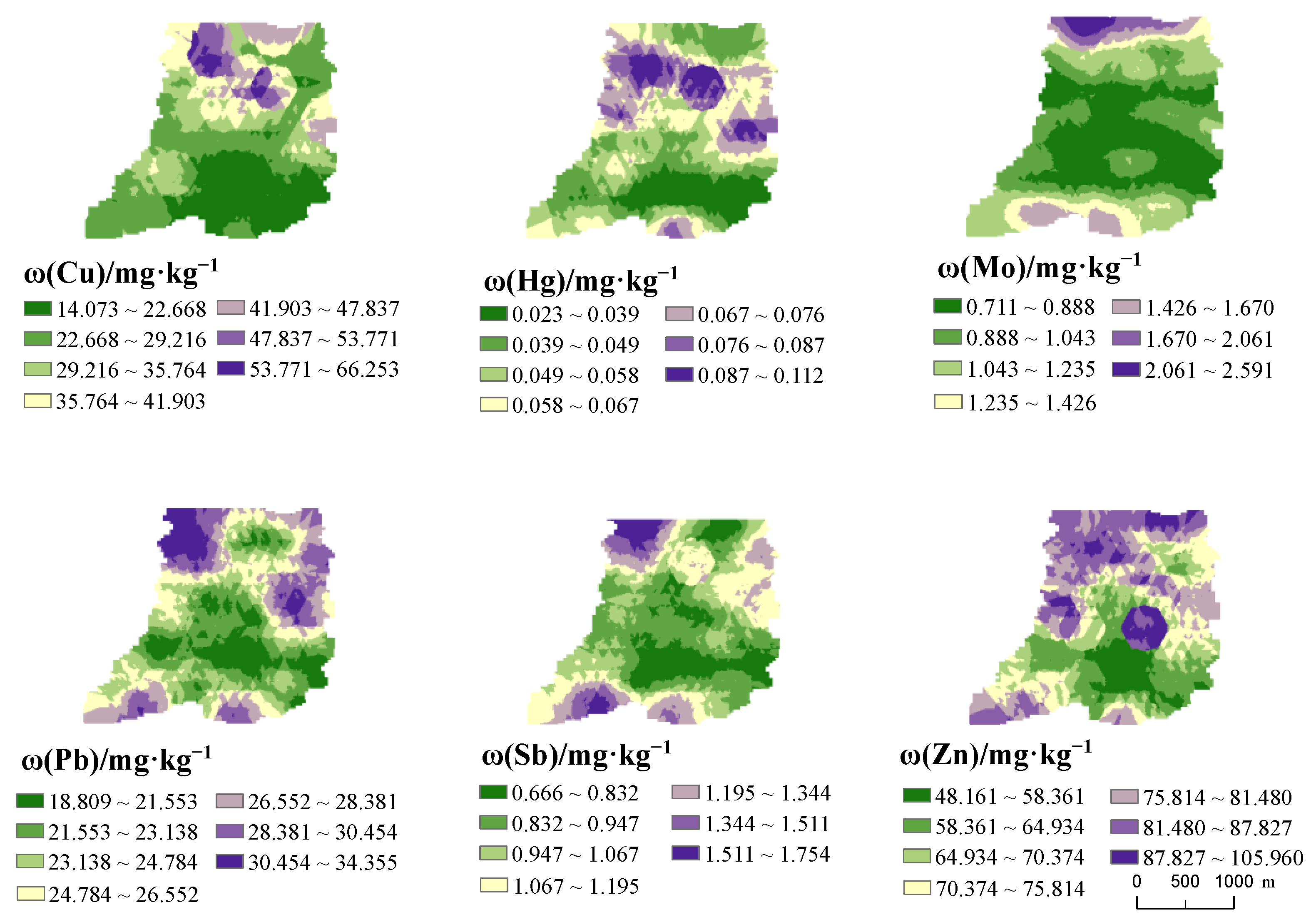
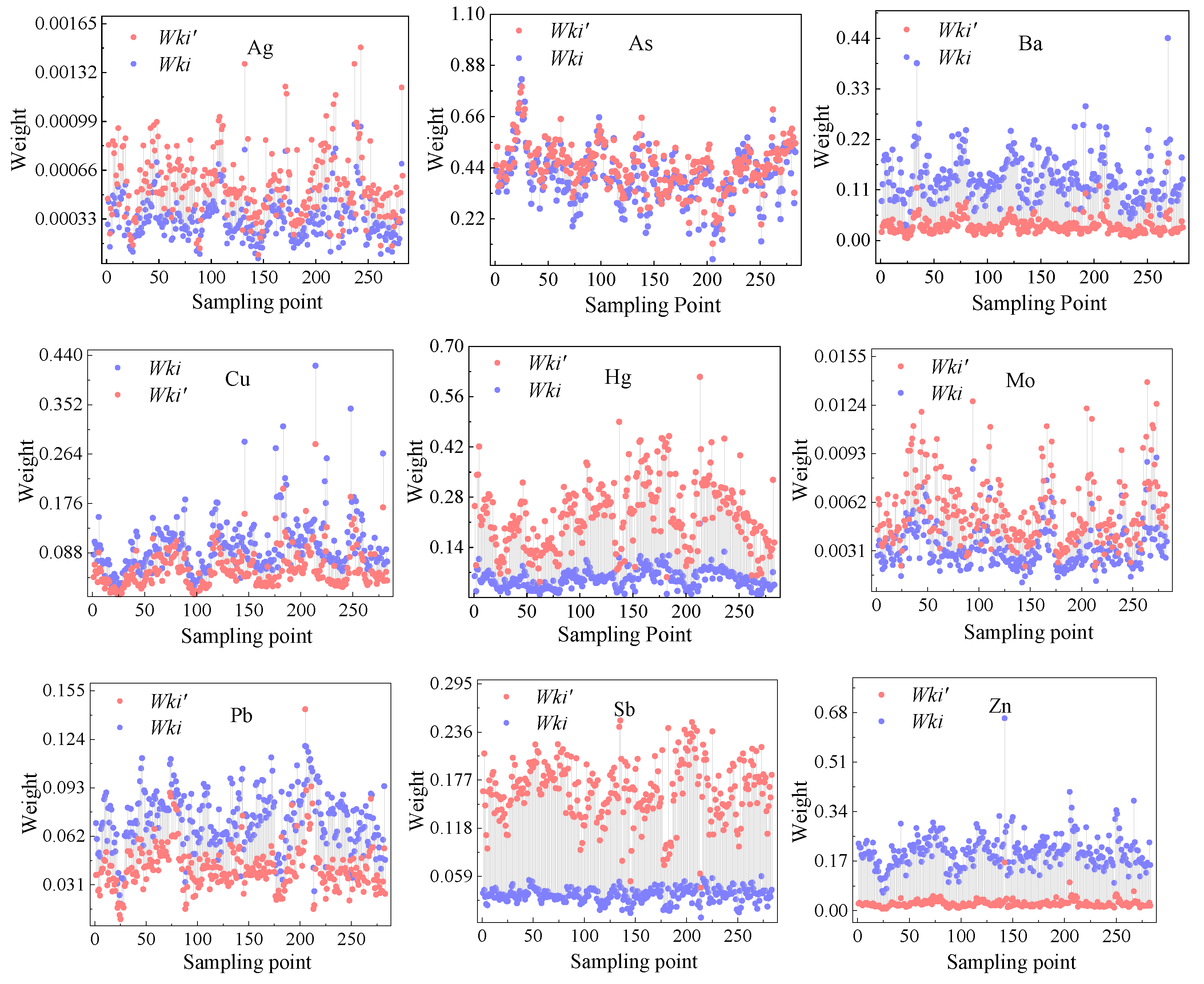

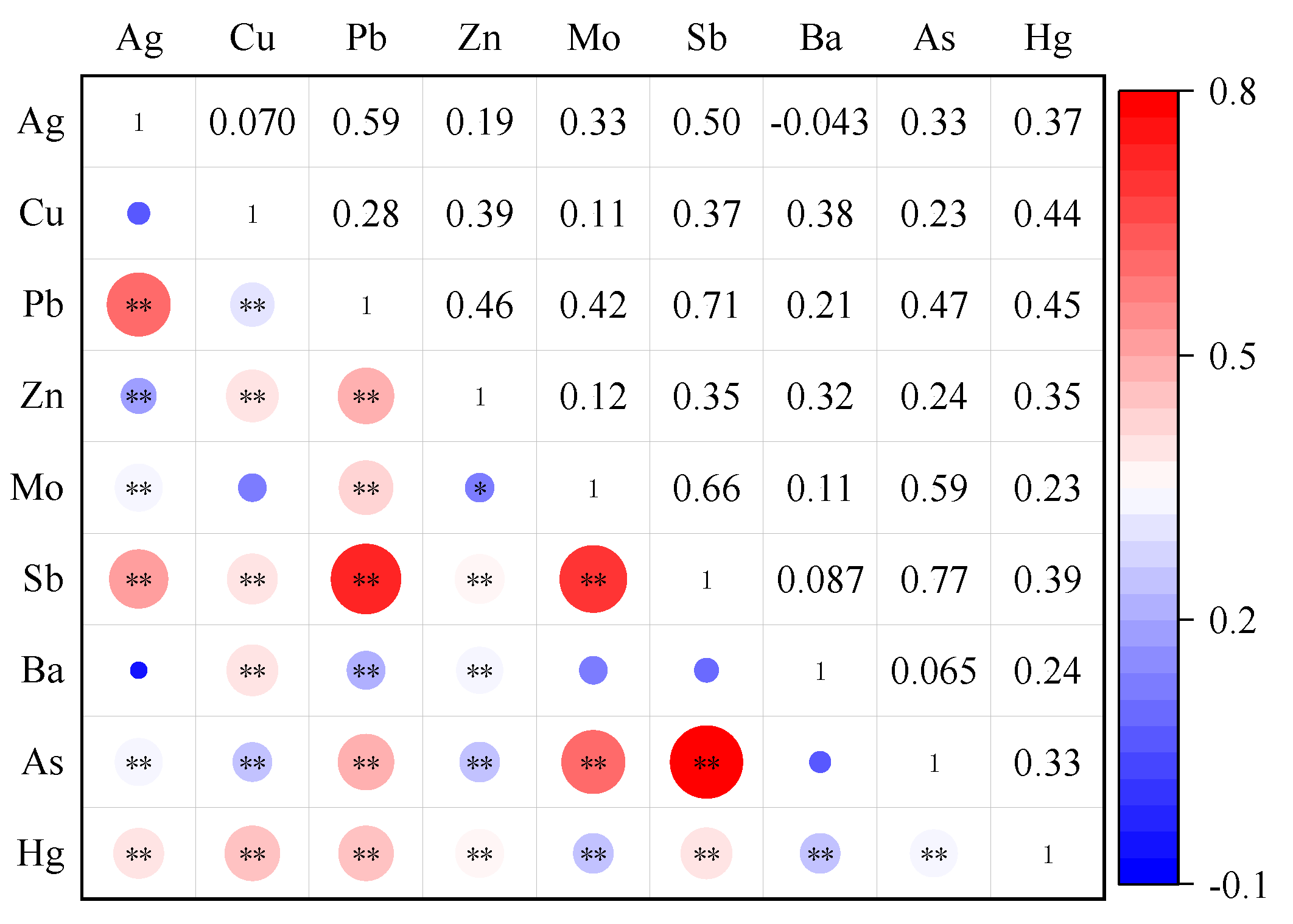
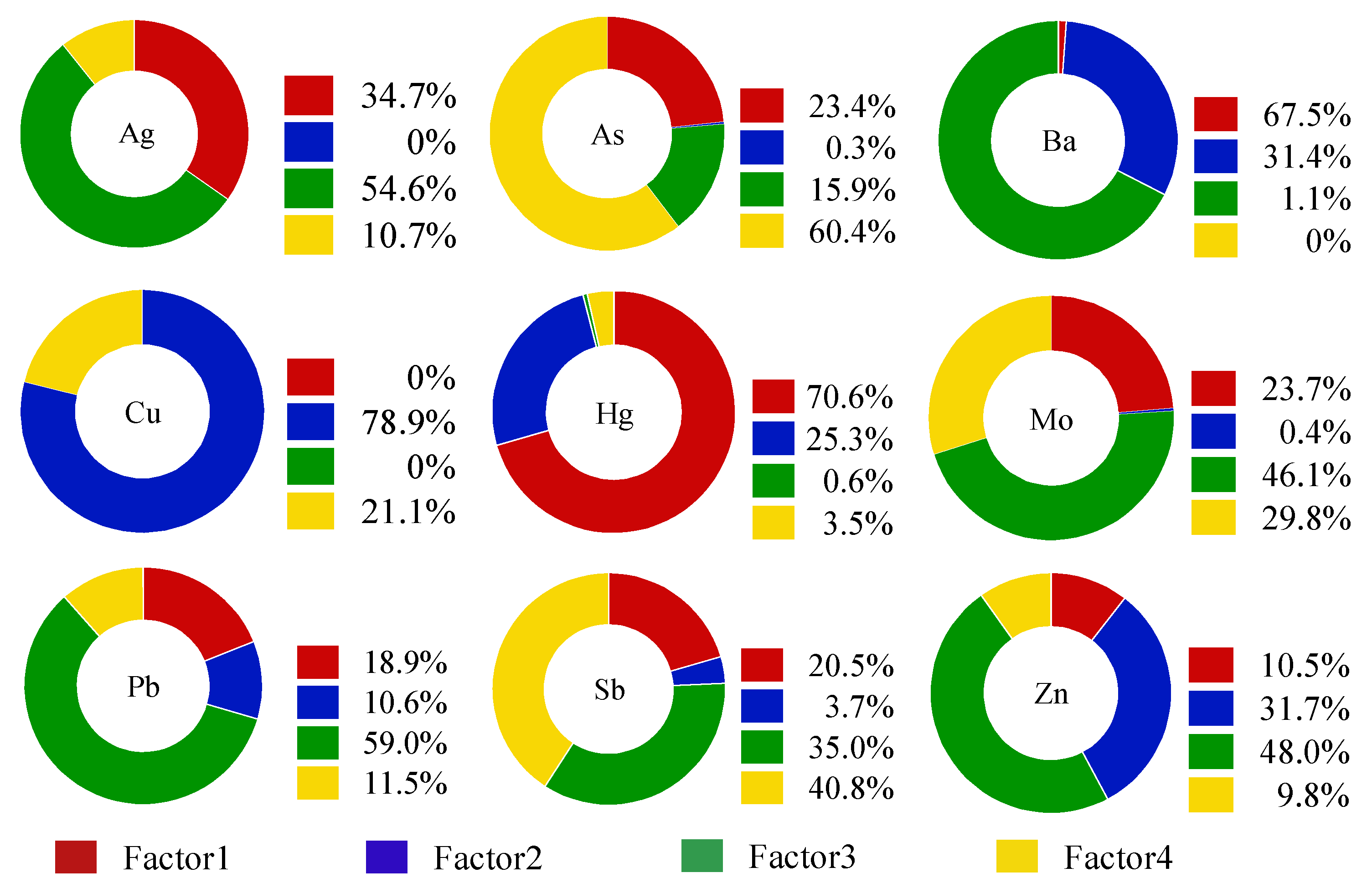
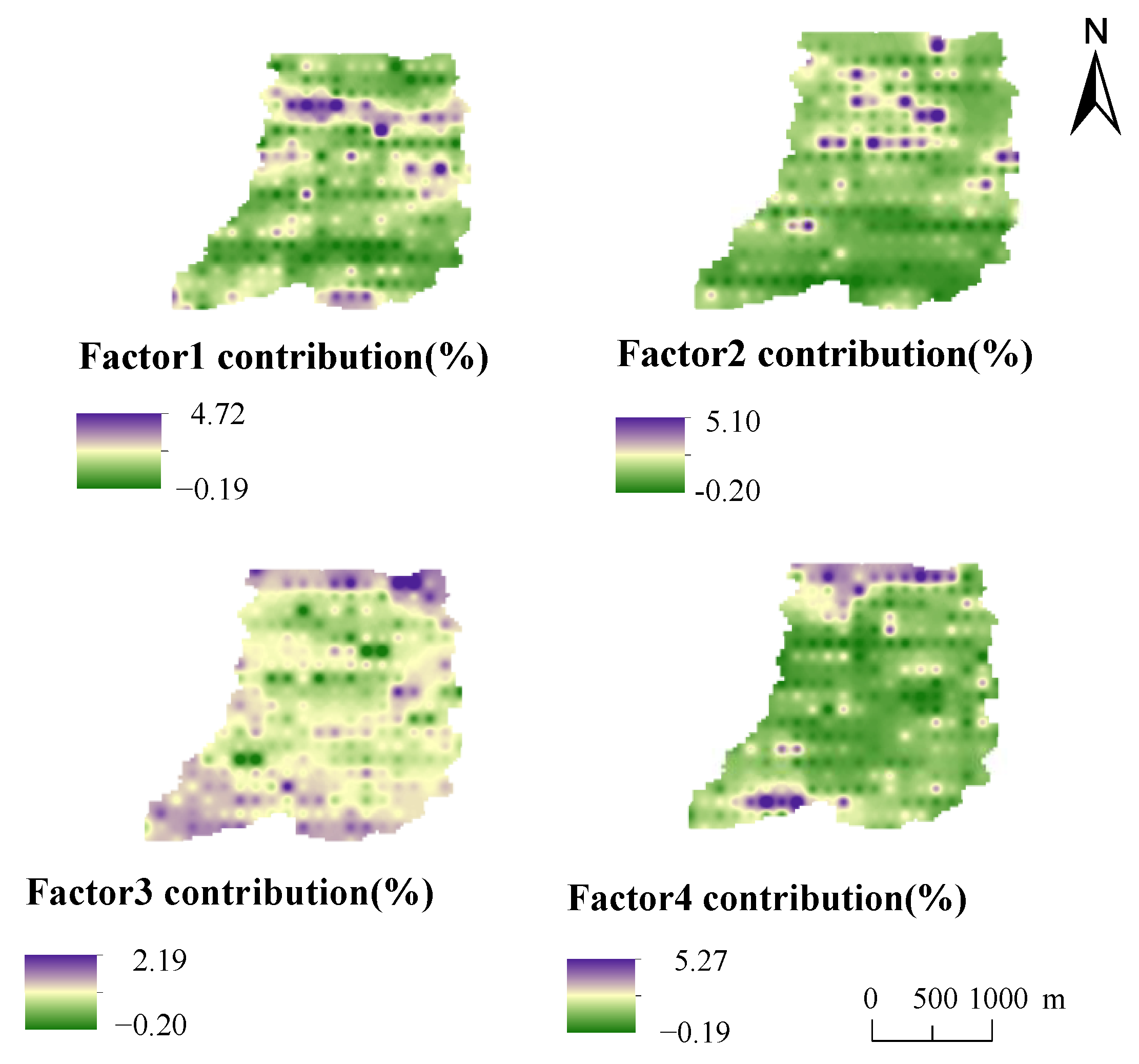
| Contamination Factor | ω | ||||||||
|---|---|---|---|---|---|---|---|---|---|
| Ag | Cu | Pb | Zn | Mo | Sb | Ba | As | Hg | |
| Cleaning I | 0.07 | 22 | 23.6 | 61.5 | 0.57 | 0.9 | 502 | 10 | 0.025 |
| Cleanliness II | 87.6 | 120 | 150 | 150 | 139.5 | 12 | 1668 | 12 | 0.45 |
| Mild pollution III | 204.4 | 280 | 350 | 350 | 325.5 | 28 | 3892 | 28 | 1.05 |
| Moderate pollution IV | 292 | 400 | 500 | 500 | 465 | 40 | 5560 | 40 | 1.5 |
| heavy pollution V | 379.6 | 520 | 650 | 650 | 604.5 | 52 | 7728 | 52 | 1.95 |
| Project | Ag | Cu | Pb | Zn | Mo | Sb | Ba | As | Hg |
|---|---|---|---|---|---|---|---|---|---|
| Background values/mg·kg−1 | 0.07 | 22 | 23.6 | 61.5 | 1.57 | 0.9 | 502 | 10 | 0.03 |
| Limit of Detection/mg·kg−1 | 0.03 | 0.7 | 1 | 5 | 0.1 | 0.3 | 1 | 0.2 | 0.002 |
| Average/mg·kg−1 | 0.066 | 30.5 | 25.09 | 73.52 | 1.057 | 1.056 | 530.9 | 13.16 | 0.058 |
| Standard deviations/mg·kg−1 | 0.03 | 25.46 | 7.258 | 31.95 | 0.515 | 0.485 | 185 | 9.029 | 0.039 |
| Maximum/mg·kg−1 | 0.177 | 208.5 | 51.17 | 404.8 | 5.998 | 3.553 | 1667 | 81.847 | 0.344 |
| Minimum/mg·kg−1 | 0.021 | 7.222 | 11.24 | 31.65 | 0.459 | 0.336 | 193.4 | 0.75627 | 0.006 |
| Coefficient of variation | 0.452 | 0.835 | 0.289 | 0.435 | 0.487 | 0.459 | 0.349 | 0.686 | 0.669 |
| Element | R2 | Slope | Intercept |
|---|---|---|---|
| Ag | 0.62193 | 0.579 | 0.0242 |
| Cu | 0.84915 | 0.6573 | 9.02897 |
| Pb | 0.899421 | 0.90508 | 2.05252 |
| Zn | 0.39664 | 0.40038 | 39.72587 |
| Mo | 0.53154 | 0.48908 | 0.44928 |
| Sb | 0.83869 | 0.79493 | 0.19022 |
| Ba | 0.97855 | 0.95017 | 24.12398 |
| As | 0.94961 | 0.87377 | 1.44268 |
| Hg | 0.9978 | 0.97296 | 0.00139 |
Publisher’s Note: MDPI stays neutral with regard to jurisdictional claims in published maps and institutional affiliations. |
© 2022 by the authors. Licensee MDPI, Basel, Switzerland. This article is an open access article distributed under the terms and conditions of the Creative Commons Attribution (CC BY) license (https://creativecommons.org/licenses/by/4.0/).
Share and Cite
Chen, H.; Wu, W.; Cao, L.; Zhou, X.; Guo, R.; Nie, L.; Shang, W. Source Analysis and Contamination Assessment of Potentially Toxic Element in Soil of Small Watershed in Mountainous Area of Southern Henan, China. Int. J. Environ. Res. Public Health 2022, 19, 13324. https://doi.org/10.3390/ijerph192013324
Chen H, Wu W, Cao L, Zhou X, Guo R, Nie L, Shang W. Source Analysis and Contamination Assessment of Potentially Toxic Element in Soil of Small Watershed in Mountainous Area of Southern Henan, China. International Journal of Environmental Research and Public Health. 2022; 19(20):13324. https://doi.org/10.3390/ijerph192013324
Chicago/Turabian StyleChen, Hang, Wei Wu, Li Cao, Xiaode Zhou, Rentai Guo, Liwei Nie, and Wenxing Shang. 2022. "Source Analysis and Contamination Assessment of Potentially Toxic Element in Soil of Small Watershed in Mountainous Area of Southern Henan, China" International Journal of Environmental Research and Public Health 19, no. 20: 13324. https://doi.org/10.3390/ijerph192013324




